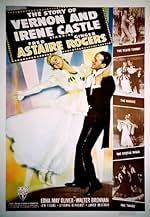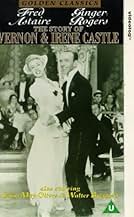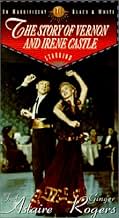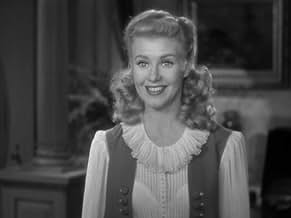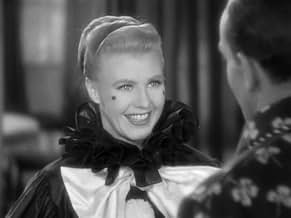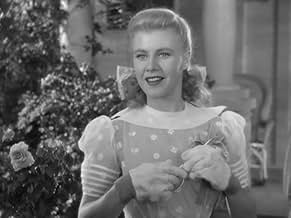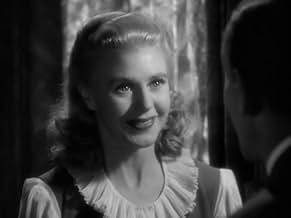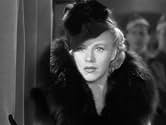IMDb RATING
6.9/10
2.9K
YOUR RATING
The story of the dancing team who taught the world to two-step.The story of the dancing team who taught the world to two-step.The story of the dancing team who taught the world to two-step.
- Awards
- 4 wins & 1 nomination total
Buzz Barton
- Undetermined Secondary Role
- (uncredited)
Max Barwyn
- Waiter - Cafe de Paris
- (uncredited)
Featured reviews
How strange to contemplate the enormous popularity of Vernon and Irene Castle before World War I and to realize that, without this film, no one would know who they are today. I hope the same is never true of Fred Astaire and Ginger Rogers' teaming. Because of their presence on film in ten movies, it shouldn't.
Based on two Irene Castle books, this movie has more plot and more drama than the other Fred and Ginger pairings, and if you can accept that it isn't "Flying Down to Rio," "Top Hat," or "Swing Time," you'll enjoy it. Ginger Rogers does a great job as Irene, in the more dramatic of the two roles, proving again what a wonderful actress she was. The dancing was, of course, great. Ginger's gowns were actually copies of Irene's trendsetting gowns. Irene's hairstyle was well-known as well, and she wanted Ginger to dye her hair dark to match her own. But Rogers refused.
Vernon and Irene, during their short pairing, introduced many dances to the public, including the "Castle Walk" and the fox trot.
The movie's ending is a sad one, but I can't agree with another poster than the final visual was trite. I kind of liked it.
Based on two Irene Castle books, this movie has more plot and more drama than the other Fred and Ginger pairings, and if you can accept that it isn't "Flying Down to Rio," "Top Hat," or "Swing Time," you'll enjoy it. Ginger Rogers does a great job as Irene, in the more dramatic of the two roles, proving again what a wonderful actress she was. The dancing was, of course, great. Ginger's gowns were actually copies of Irene's trendsetting gowns. Irene's hairstyle was well-known as well, and she wanted Ginger to dye her hair dark to match her own. But Rogers refused.
Vernon and Irene, during their short pairing, introduced many dances to the public, including the "Castle Walk" and the fox trot.
The movie's ending is a sad one, but I can't agree with another poster than the final visual was trite. I kind of liked it.
The Story of Vernon and Irene Castle is the last of the 9 RKO musicals Astaire did with Rogers. However, from a story point-of-view, it is their best film by a mile. The contest isn't even close, IMO.
It's not their best musical. This film is really a drama with a few musical interludes, whereas most of the other Astaire-Rogers films were musical comedies. Those other films had flimsy plots at best and were saved only by their songs and dances. BUT - "Vernon and Irene" could easily stands alone without any songs or dances. It even has some action sequences as is typical of war-time films (WWI, in this case).
The film is a bio-pic about the Castles, who in their heyday were even bigger than Astaire and Rogers. The choreography is more attuned to 1910's sensibilities than the usual Astaire and Rogers film, but that's okay. Astaire and Rogers dance just well as always.
As the dancing duo's last RKO film, V&C is quite classy and a fine close to a great RKO dancing career for the two.
It's not their best musical. This film is really a drama with a few musical interludes, whereas most of the other Astaire-Rogers films were musical comedies. Those other films had flimsy plots at best and were saved only by their songs and dances. BUT - "Vernon and Irene" could easily stands alone without any songs or dances. It even has some action sequences as is typical of war-time films (WWI, in this case).
The film is a bio-pic about the Castles, who in their heyday were even bigger than Astaire and Rogers. The choreography is more attuned to 1910's sensibilities than the usual Astaire and Rogers film, but that's okay. Astaire and Rogers dance just well as always.
As the dancing duo's last RKO film, V&C is quite classy and a fine close to a great RKO dancing career for the two.
This was the last of the Astaire and Rogers films at RKO (they would reunite at MGM for "The Barkeleys of Broadway" [1949]), and represents the studio attempting to find a new way to make the duo popular. It's hard to believe, since the pair have become legends in Hollywood musical history, but by the end of the 1930s audience interest in Astaire and Rogers seemed to be ebbing. Consequently, this film feels *very* different than the rest of their films.
This is not a story of boy meets girl/boy dances with girl/boy loses girl/boy chases and chases girl/boy gets girl and dances with her again. There aren't a ton of the whimsical oddball comic supporting players. And--steady yourself--there are very few full-out major musical numbers. There is no stunning score of songs by Irving Berlin or the Gershwins.
This is because this is a musical biography about the Astaire and Rogers of the previous generation. Hence, the duo are asked not to dance in the manner that made them popular but in the manner that made *the Castles* popular, and to music that *that* couple danced to. Often, when the two dance, we are interrupted by various plot points (ie., cutting to other characters talking instead of keeping the camera on the dancers). One of the few moments where we are able to enjoy them completely is a montage sequence showing the Castles becoming the toast of the nation (with Astaire and Rogers literally dancing across a giant map of the U.S.)
The other major musical number is a solo: Ginger Rogers singing "The Yama Yama Man." Astaire was about to end his contract at RKO, but Rogers still was under contract--so the studio is plainly more interested in trying to build up Rogers for a solo career, and the film indicates this (Rogers' solo, the emphasis on her clothes and hair, etc.) Meanwhile, the film also indicates a growing awareness of the coming war, by dealing with Vernon Castle's enlistment during World War I--one of the first times Astaire had donned a uniform for the cameras (something he would do a *lot* in musicals for the next 5 years).
All in all, it's not what one usually expects from an Astaire and Rogers film, and thus suffers in comparison to "Top Hat" or "Shall We Dance," but still retains a charm and personality nonetheless.
This is not a story of boy meets girl/boy dances with girl/boy loses girl/boy chases and chases girl/boy gets girl and dances with her again. There aren't a ton of the whimsical oddball comic supporting players. And--steady yourself--there are very few full-out major musical numbers. There is no stunning score of songs by Irving Berlin or the Gershwins.
This is because this is a musical biography about the Astaire and Rogers of the previous generation. Hence, the duo are asked not to dance in the manner that made them popular but in the manner that made *the Castles* popular, and to music that *that* couple danced to. Often, when the two dance, we are interrupted by various plot points (ie., cutting to other characters talking instead of keeping the camera on the dancers). One of the few moments where we are able to enjoy them completely is a montage sequence showing the Castles becoming the toast of the nation (with Astaire and Rogers literally dancing across a giant map of the U.S.)
The other major musical number is a solo: Ginger Rogers singing "The Yama Yama Man." Astaire was about to end his contract at RKO, but Rogers still was under contract--so the studio is plainly more interested in trying to build up Rogers for a solo career, and the film indicates this (Rogers' solo, the emphasis on her clothes and hair, etc.) Meanwhile, the film also indicates a growing awareness of the coming war, by dealing with Vernon Castle's enlistment during World War I--one of the first times Astaire had donned a uniform for the cameras (something he would do a *lot* in musicals for the next 5 years).
All in all, it's not what one usually expects from an Astaire and Rogers film, and thus suffers in comparison to "Top Hat" or "Shall We Dance," but still retains a charm and personality nonetheless.
There is one hilarious goof in this delightful film. When Irene and Vernon are having dinner in the Parisian restaurant in which they are to make their debut Irene is wearing her wedding dress as they are too broke to afford to buy her a new evening dress, She is also wearing a little lacy winged hat of the type worn in the national costume of Holland.
In England there were gales of laughter when Irene says "I feel just like a bride again in my wedding dress and my little Dutch cap." In the UK a Dutch cap is a female contraceptive device which I believe is called a "diaphragm" in USA.
In England there were gales of laughter when Irene says "I feel just like a bride again in my wedding dress and my little Dutch cap." In the UK a Dutch cap is a female contraceptive device which I believe is called a "diaphragm" in USA.
"Castles in the Air" is the title of Irene's 1958 autobiography but it's also an apt summarization of this robust, poignant tale. Vernon and Irene Castle were far more famous and influential in their day than Fred Astaire or Ginger Rogers were later, though they are less remembered now.
This movie pays glorious tribute to the Castles and their dance repertoire which Astaire and Rogers beautifully replicate. The crazy maze of fame that swirled around the young couple, their great love for each other and their private travail, are sensitively presented. The supporting cast includes the always superb Walter Brennan as the Castles' chaperone-servant, and Edna May Oliver as their agent, a take-off on real-life Elisabeth (Bessy) Marbury. Producer Lew Fields, who gave Vernon Castle his first job on the New York stage, makes a cameo appearance.
Although Irene Castle served as technical advisor and assisted Walter Plunkett with costuming, there were polite clashes on the set (and off) between her and Ginger Rogers who objected, most notably, to Irene's insistence that she dye her hair dark and cut it short to more accurately resemble her. For those familiar with Irene Castle, whose extraordinary looks (particularly the bobbed hair-style she introduced) were so much a part of her image, they will understand Irene's dissatisfaction with long-tressed, blonde Rogers. It says much for Ginger Rogers' capabilities that the story is not hindered by this departure from authenticity (more glaring then than today).
A NOTE ON COSTUMES:
This film gives some idea of Irene's popularity as a fashion trendsetter which was tremendous in the 1910s and 20s. In fact, many of the stunning gowns Ginger Rogers wears are quite faithful adaptations of costumes designed by Lucile (Lady Duff-Gordon) for Irene Castle during her Broadway and silent-movie days. Ginger's dress with the handkerchief hem and huge chiffon sleeves (double-banded in fur) was copied from the original which Irene wore for the premiere of Irving Berlin's "Watch Your Step" in 1914. This original, by Lucile, is now at the Costume Institute of the Metropolitan Museum of Art. A black and white evening gown, a pleated silk day dress, and a striped travelling suit are other Lucile designs reproduced by Plunkett for Rogers in this picture.
This movie pays glorious tribute to the Castles and their dance repertoire which Astaire and Rogers beautifully replicate. The crazy maze of fame that swirled around the young couple, their great love for each other and their private travail, are sensitively presented. The supporting cast includes the always superb Walter Brennan as the Castles' chaperone-servant, and Edna May Oliver as their agent, a take-off on real-life Elisabeth (Bessy) Marbury. Producer Lew Fields, who gave Vernon Castle his first job on the New York stage, makes a cameo appearance.
Although Irene Castle served as technical advisor and assisted Walter Plunkett with costuming, there were polite clashes on the set (and off) between her and Ginger Rogers who objected, most notably, to Irene's insistence that she dye her hair dark and cut it short to more accurately resemble her. For those familiar with Irene Castle, whose extraordinary looks (particularly the bobbed hair-style she introduced) were so much a part of her image, they will understand Irene's dissatisfaction with long-tressed, blonde Rogers. It says much for Ginger Rogers' capabilities that the story is not hindered by this departure from authenticity (more glaring then than today).
A NOTE ON COSTUMES:
This film gives some idea of Irene's popularity as a fashion trendsetter which was tremendous in the 1910s and 20s. In fact, many of the stunning gowns Ginger Rogers wears are quite faithful adaptations of costumes designed by Lucile (Lady Duff-Gordon) for Irene Castle during her Broadway and silent-movie days. Ginger's dress with the handkerchief hem and huge chiffon sleeves (double-banded in fur) was copied from the original which Irene wore for the premiere of Irving Berlin's "Watch Your Step" in 1914. This original, by Lucile, is now at the Costume Institute of the Metropolitan Museum of Art. A black and white evening gown, a pleated silk day dress, and a striped travelling suit are other Lucile designs reproduced by Plunkett for Rogers in this picture.
Did you know
- TriviaIrene Castle served as a technical advisor on the film. According to Ginger Rogers, Castle disliked every costume she wore and deemed them anachronistic. Due to censorship restrictions, Rogers' costumes evoked late 1930s fashions rather than the more daring styles of Castle's 1910s era. After Rogers refused to bob her hair to portray the hairstyle that Irene had popularized, Castle became more displeased. The studio silenced Castle's protests with an additional payment of $5,000.
- GoofsThe film erroneously depicts the Castles touring with white orchestras. In actuality, Vernon and Irene Castle always toured with a black orchestra; specifically, James Reese Europe's Society Orchestra.
- Quotes
Irene Castle: I thought you could be a first dancer, a very beautiful first dancer because you are a beautiful dancer but you're so smug and conceited that you can't see any further than your funny nose!
- ConnectionsFeatured in Fred Astaire: Puttin' on His Top Hat (1980)
- SoundtracksOnly When You're in My Arms
(1939)
by Con Conrad - Herman Ruby Bert Kalmar
Sung by Fred Astaire (uncredited)
End dance: Fred Astaire (uncredited) and Ginger Rogers (uncredited)
- How long is The Story of Vernon and Irene Castle?Powered by Alexa
Details
Box office
- Budget
- $1,196,000 (estimated)
- Runtime
- 1h 33m(93 min)
- Color
- Aspect ratio
- 1.37 : 1
Contribute to this page
Suggest an edit or add missing content

